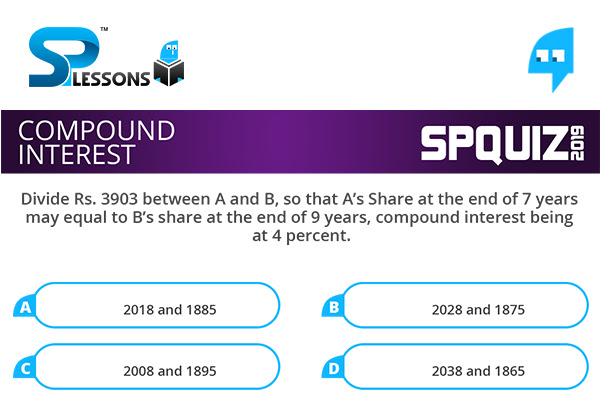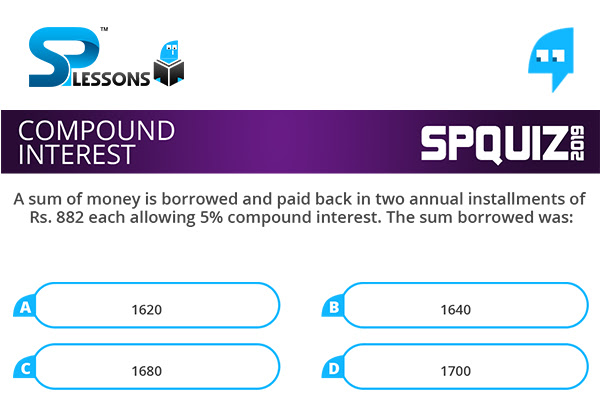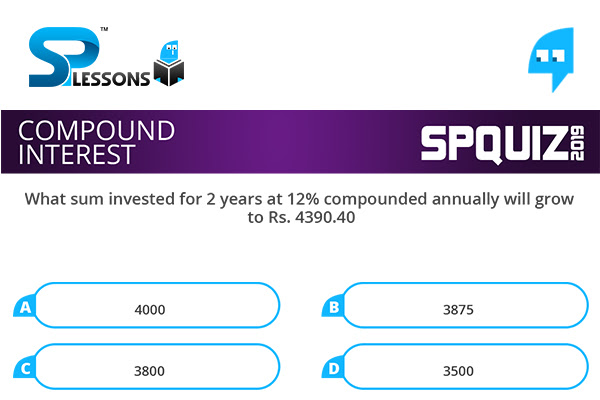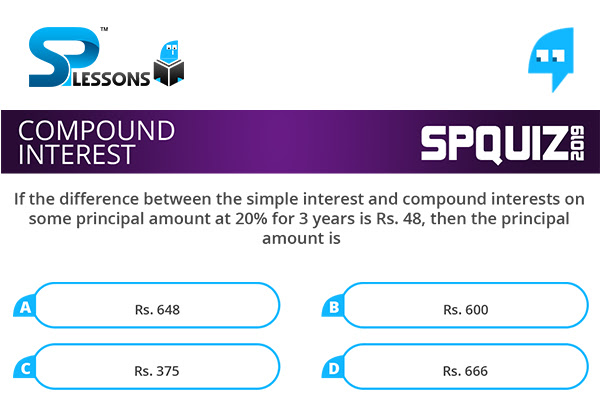 Introduction
Introduction
What is compound interest?
Compound interest is the addition of interest to the principal sum of a loan or deposit, or in other words, interest on interest. It is the result of reinvesting interest, rather than paying it out, so that interest in the next period is then earned on the principal sum plus previously accumulated interest.
Compound Interest is one of important topic in Quantitative Aptitude Section. In Compound Interest Quiz 12 article candidates can find questions with answer. By solving this questions candidates can improve and maintain, speed, and accuracy in the exams. Compound Interest Quiz 12 questions are very useful for different exams such as IBPS PO, Clerk, SSC CGL, SBI PO, NIACL Assistant, NICL AO, IBPS SO, RRB, Railways, Civil Services etc.
 Q1
Q1
If a sum on compound interest becomes three times in 4 years, then with the same interest rate, the sum will become 27 times in:
- A. 8 years
B. 12 years
C. 24 years
D. 36 years
[latex]P{(1 + \frac {R}{100} )}^{4}[/latex] = 3P
[latex]{(1 + \frac {R}{100} )}^{4}[/latex] = 3 …(i)
Let P
[latex]{(1 + \frac {R}{100} )}^{n}[/latex] = 27P
[latex] (1 + \frac {R}{100} )n = 27 = P{(3)}^{3} = P{(1 + \frac {R}{100} )}^{(4×3)}[/latex] [using (i)]
[latex]{(1 + \frac {R}{100} )}^{n} {(1 + \frac {R}{100} )}^{12}[/latex]
n = 12
Required time = 12 years.
 Q2
Q2
Divide Rs. 3903 between A and B, so that A’s Share at the end of 7 years may equal to B’s share at the end of 9 years, compound interest being at 4 percent.
- A. 2018 and 1885
B. 2028 and 1875
C. 2008 and 1895
D. 2038 and 1865
We have (A’s present share) [latex]{(1 + \frac {4}{100} )}^{7}[/latex] = (B’s present share) [latex]{(1 + \frac {4}{100} )}^{9}[/latex]
A’s present share = [latex]{(1 + \frac {4}{100} )}^{2}[/latex]
B’s present share
=[latex]{(\frac {26}{25}) }^{2} = \frac {676}{625}[/latex]
Dividing Rs. 3903 in the ratio of 676:625
A’s present share = [latex]\frac {676}{(676+625)}[/latex] of Rs. 3903
= Rs. 2028
B’s present share = Rs. 3903 – Rs. 2028
= Rs. 1875
 Q3
Q3
A sum of money is borrowed and paid back in two annual installments of Rs. 882 each allowing 5% compound interest. The sum borrowed was:
- A. 1620
B. 1640
C. 1680
D. 1700
[latex]{(1 + \frac {4}{100} )}^{7}[/latex]
[latex]\frac {882}{(1+ \frac {5}{100})} + \frac {882}{{(1+ \frac {5}{100})}^{2}}[/latex]
= [latex]882 \times \frac {20}{21} + 882 \times \frac {400}{441}[/latex]
= Rs. 1640
 Q4
Q4
What sum invested for 2 years at 12% compounded annually will grow to Rs. 4390.40
- A. 4000
B. 3875
C. 3800
D. 3500
[latex]P{(1 + \frac {R}{100} )}^{T}[/latex] = Amount
[latex]\Rightarrow P{(1 + \frac {12}{100} )}^{2}[/latex] = 4390.40
[latex]\Rightarrow P {(\frac {112}{100})}^{2} = 4390.40[/latex]
[latex]\Rightarrow P =\frac {43904000}{112 x 112}[/latex] = 3500.
 Q5
Q5
If the difference between the simple interest and compound interests on some principal amount at 20% for 3 years is Rs. 48, then the principal amount is
- A. Rs. 648
B. Rs. 600
C. Rs. 375
D. Rs. 666
Sum = [latex]\frac {x \times {(100)}^{3}}{{r}^{2} (300 + r)}[/latex]
[latex]\frac {48 \times {(100)}^{3}}{{20}^{2} (300 + 20)}[/latex]
= Rs. 375








